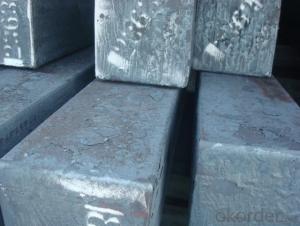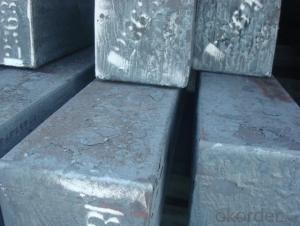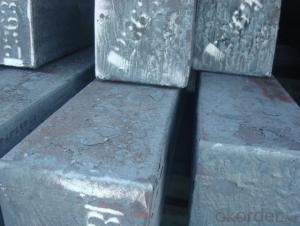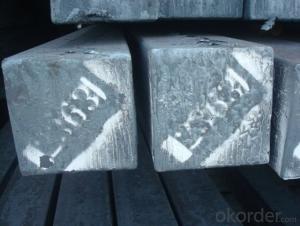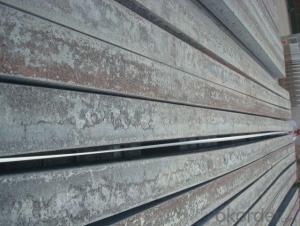Continue Casting Steel Billet Made by Blast Furnace
- Loading Port:
- Tianjin
- Payment Terms:
- TT OR LC
- Min Order Qty:
- 1000 m.t.
- Supply Capability:
- 100000 m.t./month
OKorder Service Pledge
OKorder Financial Service
You Might Also Like
Continue Casting Steel Billet Made by Blast Furnace
1.Structure of Continue Casting Steel Billet Made by Blast Furnace
Continue Casting Steel Bloom by Blast Furnace is the raw material of all kinds of steel mill. Billet section of square, round, flat, rectangular and abnormity, etc Several, mainly related to shape of rolled products. Simple rolled section steel, choose cross section of square billet or rectangular billet. rolling The sector products such as flat steel, Angle steel, select the rectangular billet or slab. Had better profiled billet when production beams, channels, and in rolling process Lines and improve the yield. The raw material of round billet is the production of seamless tube.
2.Main Features of Continue Casting Steel Billet Made by Blast Furnace
Continue Casting Steel Bloom by Blast Furnace section size should meet the requirements of rolling deformation and finished product quality, but also roll strength and biting condition of restrictions. General steel Billet section height H. And the roll diameter D The ratio of the ( namely H/D) Should be less than or equal to zero 0.5 . Length of steel billet by finishing temperature, Rolling time and the length of the product Or times ruler. When heated too long accident prone to bump the furnace wall of steel, too short, furnace bottom utilization rate is not high, influence the heating furnace production. For the production Choose a variety of steel and steel billet, should consider the affinities of billet, as far as possible in order to improve the productivity of the roughing mill, simplify the stock management of workshop.
3. Continue Casting Steel Billet Made by Blast Furnace Images
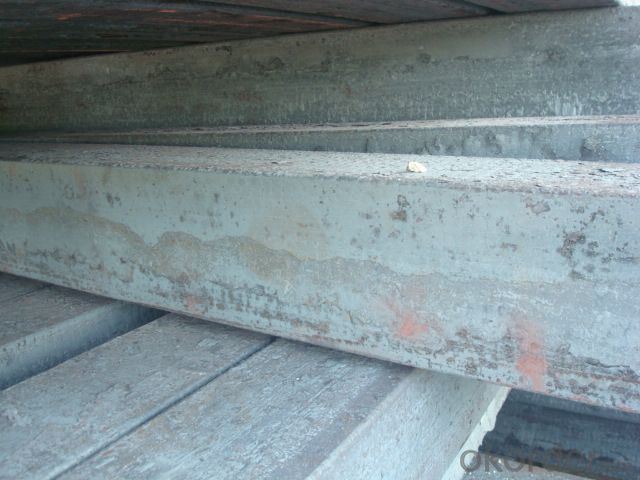

4. Continue Casting Steel Billet Made by Blast Furnace Specification
Continue Casting Steel Bloom by Blast Furnace rolled steel, after processing can be used for mechanical parts, forging parts, processing all kinds of steel, steel Q345B channel steel, wire rod is the role of the billet. Steel billet is used in the production of semi-finished products, generally cannot be used directly for the society. Steel billets and steel are strictly divided into standard, cannot decide to whether the business enterprise of the final product, and according to unified standards to perform the whole society. Typically, billet and the steel is relatively easy to distinguish, but for some steel billet, and have the same specification and same steel purposes (such as rolling tube billet), whether can be used for other industries, whether through steel processing process, whether through a finished product rolling mill processing to distinguish
Mainly from the shape is divided into two kinds:Slab: cross section width and height of the ratio of the larger, mainly used for rolling plate.Billet: equal cross section width and height, or a huge difference, mainly used for rolling steel, wire rod.Material part of the standard:Range of thickness: 150-240 - mm + / - 5 mmThe width of the range: 880-1530 - mm + / - 20 mmLength: 3700-10000 - mm + / - 500 - mmCross-sectional size: 64 * 64;82 * 82;98 * 98;124 * 124;120 * 150;152 * 164;152 * 170 mm
5.FAQ of Continue Casting Steel Billet Made by Blast Furnace
We have organized several common questions for our clients,may help you sincerely:
①How we can recoginize the blast furnace and the efa quality?
If you see the surface only, not very easy to recognize, it is better you buy from CNBM and we have to keep the contract as we sign, it is more relieable.
②Could we get the original MTC from the steel mill?
Yes, you can.
③If we found any quality problem, how long you can settel that for us?
about 7-30days with SGS report.
- Q: How do steel billets compare to other metal billets?
- Steel billets are generally considered superior to other metal billets due to their high strength, durability, and versatility. Steel billets offer excellent weldability, machinability, and resistance to corrosion, making them suitable for a wide range of applications in industries such as construction, automotive, and manufacturing. Additionally, steel billets can be easily modified and shaped into various forms, allowing for efficient and precise fabrication processes.
- Q: Difference between medium frequency continuous casting billet and electric furnace continuous casting billet
- 5, if the intermediate frequency furnace supporting a reasonable refining facilities, also can produce high quality steel, even more than the electric arc furnace steelmaking, specific processes can be used: +VOD+LF process of intermediate frequency furnace can produce very good steel.
- Q: How are steel billets used in the manufacturing of pressure vessels?
- Pressure vessels require steel billets as a necessary part of their manufacturing process. These metal products are in a semi-finished state and are typically made through casting or extrusion. The billets are molded into a solid square or rectangular shape to ensure consistent and uniform material for further processing. To initiate the manufacturing process, the steel billets are heated to a specific temperature, making them more malleable and easier to handle. Once heated, they are placed into a forging machine, where intense pressure and shaping take place. This forging process effectively eliminates any defects or inconsistencies in the billet's structure, resulting in a stronger and more durable material. After the forging stage, the steel billets undergo additional processing using different techniques like rolling or machining. These techniques are employed to achieve the desired dimensions and shape required for pressure vessel fabrication. By refining the billet's surface finish and improving its mechanical properties, these techniques enhance the overall quality of the billet. Once the billets have been shaped and processed, they are cut into smaller sections that serve as the foundation for constructing pressure vessels. These sections are welded together to form the vessel's shell, ensuring a secure and tight seal to contain high-pressure fluids or gases. The use of steel billets in pressure vessel manufacturing is critical due to their superior strength, durability, and resistance to high-pressure environments. The uniformity and consistency of the billets provide a reliable material for fabricating vessels that can endure extreme conditions, guaranteeing the safety and integrity of the contents within. In conclusion, steel billets play a crucial role in the manufacturing of pressure vessels by providing the core components for constructing the vessel's shell. Through a series of heating, forging, and processing techniques, the billets are transformed into robust and enduring sections that are then welded together to form the final vessel. The utilization of steel billets ensures the structural integrity and dependability of pressure vessels, making them suitable for a wide range of industrial applications.
- Q: How do steel billets contribute to the water treatment industry?
- Steel billets are used in the water treatment industry to manufacture various components such as pipes, valves, and fittings. These components are vital for the construction and maintenance of water treatment infrastructure. Steel billets provide the necessary strength, durability, and corrosion resistance needed to withstand harsh conditions and chemicals involved in water treatment processes. Thus, steel billets play a crucial role in ensuring the efficiency and longevity of water treatment systems.
- Q: How are steel billets used in the manufacturing of construction cranes?
- Steel billets are used in the manufacturing of construction cranes as the primary raw material. They are heated and shaped into various components, such as beams, columns, and tracks, which provide structural strength and support to the crane. These components are then assembled and welded together to create the framework of the crane, ensuring durability and stability for lifting heavy loads in construction projects.
- Q: What are the main factors affecting the machinability of steel billets?
- Several key factors influence the machinability of steel billets, which refers to the ease with which they can be cut and shaped by machining processes. These factors encompass the composition of the steel, its microstructure, the presence of impurities or inclusions, and the mechanical properties of the material. The machinability of steel is significantly impacted by its composition. Elements like carbon, manganese, sulfur, and phosphorus play a crucial role in determining the cutting performance. For example, a higher carbon content can increase hardness, thereby making the steel more challenging to machine. Conversely, manganese can enhance machinability by promoting the formation of a favorable microstructure. The microstructure of the steel, influenced by factors such as heat treatment and alloying elements, also affects machinability. Fine-grained steels with a homogeneous microstructure are generally easier to machine compared to coarse-grained ones. Additionally, the inclusion of alloying elements like chromium or molybdenum can enhance machinability by increasing the material's hardness and wear resistance. Machinability can be negatively affected by impurities or inclusions present in the steel, such as non-metallic particles or oxides. These impurities can result in tool wear, surface defects, and inadequate chip formation during machining. Therefore, minimizing the level of impurities in the steel through meticulous production and refining processes is crucial. Moreover, the mechanical properties of the steel, including hardness, strength, and ductility, impact machinability. High-strength steels tend to be more challenging to machine due to their increased hardness, necessitating greater cutting force. Ductility also plays a vital role as it affects the steel's ability to form chips during machining. Striking a balance between hardness and ductility is desirable for optimal machinability. In conclusion, the machinability of steel billets is influenced by various factors encompassing composition, microstructure, impurities, and mechanical properties. It is imperative to comprehend and control these factors to ensure efficient and effective machining processes.
- Q: 20 what is the difference between manganese silicon steel billet and Q235 billet?
- In brief, the ingredients are different and the uses are different.20 manganese silicon steel billet for high strength steel,Q235 billet is almost the most common steel, requiring the lowest.
- Q: What is the average lead time for ordering steel billets?
- The average lead time for ordering steel billets can vary depending on various factors such as the supplier, quantity required, and current market conditions. However, on average, it can range from a few weeks to a couple of months.
- Q: How are steel billets used in the production of industrial furnaces?
- Steel billets are used in the production of industrial furnaces as the primary raw material for constructing the furnace structure and components. These billets are melted and molded into various shapes and sizes to create the furnace body, walls, doors, and other necessary parts. The high strength and heat resistance of steel make it ideal for withstanding the extreme temperatures and harsh conditions within the furnace, ensuring its durability and longevity.
- Q: What are the different surface treatments for rust prevention in steel billets?
- There are several surface treatments commonly used for rust prevention in steel billets. These include hot-dip galvanizing, electroplating, painting, and applying protective coatings such as zinc-rich primers or epoxy coatings. Each treatment offers varying levels of protection, with hot-dip galvanizing typically being the most effective and durable option.
Send your message to us
Continue Casting Steel Billet Made by Blast Furnace
- Loading Port:
- Tianjin
- Payment Terms:
- TT OR LC
- Min Order Qty:
- 1000 m.t.
- Supply Capability:
- 100000 m.t./month
OKorder Service Pledge
OKorder Financial Service
Similar products
Hot products
Hot Searches
Related keywords
